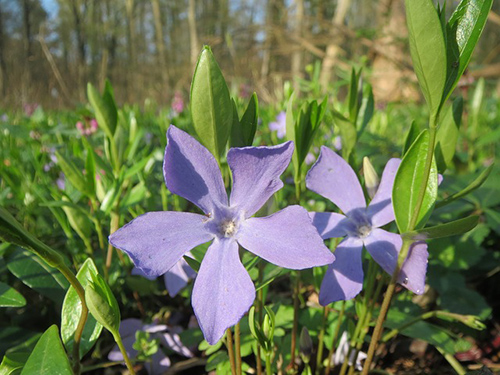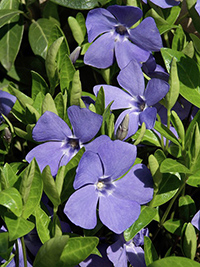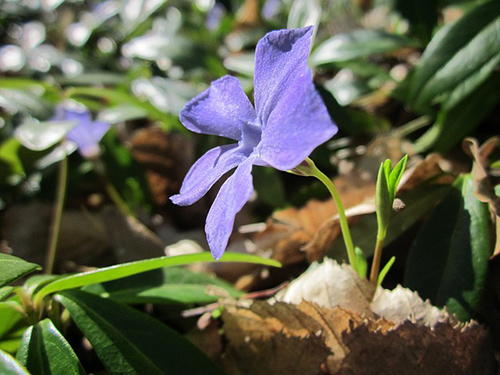Contents
The great Greek physicians, pharmacologists, botanists, and authors Pedanius Dioscorides and Galen discussed the lesser periwinkle plant, to which pharmacological research has been dedicated with great interest over the past years. Nowadays, several pharmaceutical preparations for this plant are available.

Healing Properties and Indications
The lesser periwinkle plant’s most active components are vincamine and indolic alkaloid, with remarkable vasodilating properties. It also contains tannins with an astringent action and up to 35 other alkaloids recently identified. The following are the plant’s uses:
- Cerebral circulatory insufficiency: Vincamin is a potent vasodilator of the cerebral arteries. It increases blood circulation in the brain tissues and improves the function of the central nervous system. It also has hypotensive properties. Vincamine is successfully applied for headaches, vertigo, ear buzzing (tinnitus), and other manifestations of cerebral circulatory insufficiency (lack of blood flow) due to arteriosclerosis, high blood pressure, or other reasons. It is an ideal plant to fight the disorders caused by aging.
Recently, it has been proven that vincamine crosses the hematoencephalic barrier and acts on the brain tissues, improving the oxygenation of the neurons. For these reasons, vincamine extracted from this plant is one of the most used pharmacological substances in treating insufficient cerebral blood flow. The whole plant possesses the same effects as vincamine, which are improved by other alkaloids and active components. - Migraines: The lesser periwinkle is also helpful against migraines. It helps to ease the painful crises and prevent them from recurring.
- Hemorrhages: The astringent and hemostatic effect of its tannins explains that the lesser periwinkle plant was used to stop hemoptysis (bronchial hemorrhage) that appeared with tuberculosis in ancient times. Its present use is only justified as a complement to specific anti-tuberculosis treatment. It is externally applied for bleeding wounds, hematomas, and bruises to reduce bleeding.
- Colitis and gastroenteritis: The lesser periwinkle plant can stop diarrhea.
- Diabetes: The alkaloids of the lesser periwinkle plant present a mild hypoglycemic effect by decreasing glucose in the blood and reducing glucosuria (the elimination of glucose in the urine). In the case of diabetes, it is used in combination with diet and other treatments.
- Galactofuge: It stops the production of milk in breastfeeding women. It is taken orally and applied in compresses on the breasts for inflammation or when a mother wishes to stop breastfeeding.
- General and digestive system strengthener.

Lesser Periwinkle Scientific Facts
- Other names: Early-flowering periwinkle, greater periwinkle.
- French: Pervenche, violette des morts.
- Spanish: Vincapervinca, hierba doncella.
- Environment: Common in central and southern Europe, it grows in wet forests, especially oak and beech bushes. The plant is farmed in North America for medicinal purposes.
- Description: Vivacious plant of the Apocynaceae family, with ground stems up to two meters long, evergreen, coriaceous leaves, pedunculated, violet-blue flowers, and a very sour flavor.
- Parts of the plant used medicinally: The leaves.
How to use Lesser Periwinkle

- Decoction with 30-50g of leaves per liter of water, boiling for two minutes. Drink three to five cups daily, sweetened if desired with honey (the liquid is very sour).
- Pharmaceutical preparations (capsules, syrups, etc.). Follow the recommended doses and indications for each case.
- Compresses on the skin or the breasts (to stop breastfeeding), with the same decoction described for internal use. Apply 1—15 minutes, twice or thrice daily. In the case of hemorrhages or bruises, apply cold; however, apply warm compresses to inflamed breasts.
Forget-me-Not Plant
The forget-me-not is a plant of a similar species to the lesser periwinkle. It is native to Madagascar, though it is farmed in America, where it has many names, depending on where it is cultivated. The plant is beginning to be used as an antimitotic (prevents the reproduction of cancer cells) in treating certain leukemias (the disease of Hodgkin and others) and sarcomas. Its use is still experimental.
DISCLAIMER: All content on this website is presented solely for educational and informational objectives. Do not rely on the information provided as a replacement for advice, diagnosis, or treatment from a qualified medical expert. If you are pregnant, nursing, or have any preexisting medical concerns, talk to your doctor before using any herbal or natural medicines.
REFERENCES
- George D. Pamplona-Roger, M.D. “Encyclopedia of Medicinal Plants.” George D. Pamplona-Roger, M.D. Encyclopedia of Medicinal Plants. Ed. Francesc X. Gelabert. vols. 1 San Fernando de Henares: Editorial Safeliz, 2000. 244, 245. Print.
- PubMed https://pubmed.ncbi.nlm.nih.gov/
- Google Scholar https://scholar.google.com/
- National Center for Complementary and Integrative Health (NCCIH) https://www.nccih.nih.gov/
